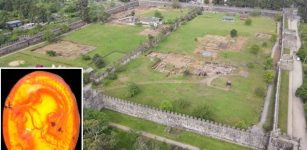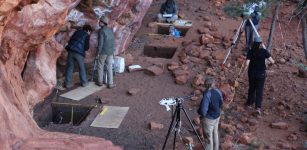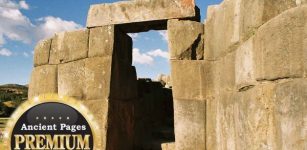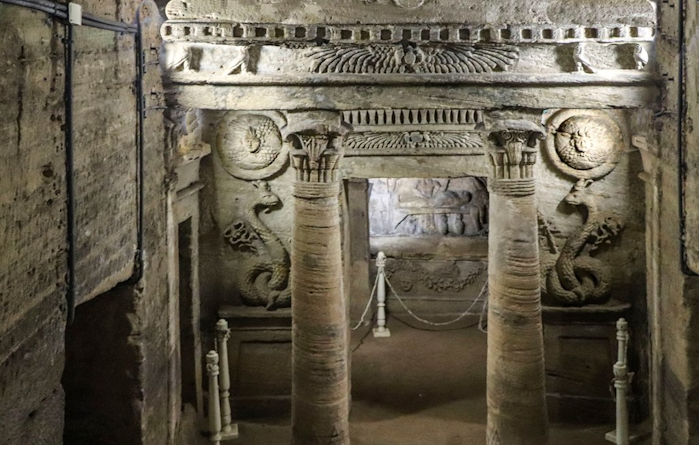Underground Catacombs Of Alexandria: Ancient Time Capsule Which Remained Hidden For Almost Two Millennia
A. Sutherland - AncientPages.com - The catacombs of Alexandria - one of the best-preserved Alexandrian complexes are the largest burial site dating back to the Greco-Roman period in Egypt.
Entrance of the principal tomb chamber. Credit: Clemens Schmillen - CC BY-SA 4.0
They are situated in the vicinity of Pompey's Pillar, a Roman triumphal column, and represent the largest of its type of construction that can be found outside of Rome and Constantinople.
The catacombs (Kom El Shuqafa, which means hill of treasures) were discovered accidentally at the beginning of the 20th century when one day, a donkey-drawn cart fell into a pit, which led to this crucial historical discovery.
The old place, dating back to the 2nd century AD, is fascinating because its architecture and decorative art have been influenced by Roman, Hellenistic, Pharaonic, and ancient Egyptian art.
The underground structure is like a time capsule, which remained hidden and undisturbed for almost two millennia.
Credit: Clemens Schmillen - CC BY-SA 4.0
The cemetery - underground tunnels dug inside the rock to a depth of 35 meters (115 feet) - consists of three levels, all located underground. Still, the lowest level of the catacombs suffered due to the flooding, which took place in the area, so it is now inaccessible.
Still, there are structures such as a spiral staircase of 99 steps, a shaft to lower the deceased's body using ropes, a dome, a banquette hall, and a vestibule with two shell-shaped niches. In one alcove to the east is a statue of a man, and to the west, there is a statue of a woman.
Decorated sarcophagus and panel with Apus-bull. Credit: Clemens Schmillen - CC BY-SA 4.0
Both statues were sculpted with the influence of Egyptian art, with some Greek features.
In the vestibule, there is an antechamber and a burial chamber with three recesses. In each of them, there is a coffin.
Other elements from mingling cultures are the winged sun disk, the Falcon God Horus, the Uraeus, or the cobra.
Central panel with Anubis mummifying a body. Credit: Clemens Schmillen - CC BY-SA 4.0
The cemetery consists of statues, human heads, Alexandrian tombs, and Pharaonic funeral cult archaeological objects strongly influenced by the Hellenistic and early Imperial Roman periods.
The catacombs were used for the last time in the 4th century AD.
Alexandria was initially established by Alexander the Great, the most famous Greek King and army leader, in 332 BC. It soon became the cultural and commercial center of the Mediterranean Sea region.
The Catacombs of Alexandria are the result of the mingling of the Greek and the Pharaonic cultures that lived side by side. At first, these were private tombs, which later became public burial places.
Written by – A. Sutherland - AncientPages.com Senior Staff Writer
Updated on February 12, 2023
Copyright © AncientPages.com All rights reserved. This material may not be published, broadcast, rewritten or redistributed in whole or part without the express written permission of AncientPages.com
Expand for referencesReferences:
Christensen w., Empire of Ancient Egypt
Johnson, P. The Civilization Of Ancient Egypt
More From Ancient Pages
-
 Roman Fort Of Apsaros Reveal Some Of Its Archaeological Secrets
Archaeology | Nov 7, 2023
Roman Fort Of Apsaros Reveal Some Of Its Archaeological Secrets
Archaeology | Nov 7, 2023 -
 Ancient Egyptian Knowledge Of The Cosmic Engine And Unseen God Of The Universe
Featured Stories | Jan 15, 2019
Ancient Egyptian Knowledge Of The Cosmic Engine And Unseen God Of The Universe
Featured Stories | Jan 15, 2019 -
 Forbidden Knowledge: Secret Ancient Gates Of The Shining Ones – More Surprising Discoveries – Part 3
Featured Stories | Jul 19, 2019
Forbidden Knowledge: Secret Ancient Gates Of The Shining Ones – More Surprising Discoveries – Part 3
Featured Stories | Jul 19, 2019 -
 DNA From 3,800-Year-Old Individuals Sheds New Light On Bronze Age Families
Archaeology | Aug 29, 2023
DNA From 3,800-Year-Old Individuals Sheds New Light On Bronze Age Families
Archaeology | Aug 29, 2023 -
 In Search Of The Mysterious Fountain Of Youth
Featured Stories | Apr 27, 2015
In Search Of The Mysterious Fountain Of Youth
Featured Stories | Apr 27, 2015 -
 10 Norse Gods Who Vikings Gained Strength From
Featured Stories | May 14, 2018
10 Norse Gods Who Vikings Gained Strength From
Featured Stories | May 14, 2018 -
 Mysterious Shemsu Hor – Followers Of Horus Were Semi-Divine Kings And Keepers Of Sacred Knowledge In Predynastic Egypt
Civilizations | May 15, 2017
Mysterious Shemsu Hor – Followers Of Horus Were Semi-Divine Kings And Keepers Of Sacred Knowledge In Predynastic Egypt
Civilizations | May 15, 2017 -
 Ruins Of Ancient Jerusalem Shed New Light On Earth’s Magnetic Field’s Behavior
Ancient Symbols | Aug 11, 2020
Ruins Of Ancient Jerusalem Shed New Light On Earth’s Magnetic Field’s Behavior
Ancient Symbols | Aug 11, 2020 -
 What America’s First Board Game Can Teach Us About The Aspirations Of A Young Nation
Featured Stories | Jun 6, 2024
What America’s First Board Game Can Teach Us About The Aspirations Of A Young Nation
Featured Stories | Jun 6, 2024 -
 7,000-Year-Old ‘Immortal City’ Of Misis – Excavations Shed Light On Its Fall
Archaeology | Aug 25, 2015
7,000-Year-Old ‘Immortal City’ Of Misis – Excavations Shed Light On Its Fall
Archaeology | Aug 25, 2015 -
 Ancient Campfires Reveal A 50,000-Year-Old Grocer And Pharmacy In Australia
Archaeology | Apr 14, 2022
Ancient Campfires Reveal A 50,000-Year-Old Grocer And Pharmacy In Australia
Archaeology | Apr 14, 2022 -
 Giants Of The Jurassic Seas Were Twice The Size Of A Killer Whale – New Study
Fossils | May 11, 2023
Giants Of The Jurassic Seas Were Twice The Size Of A Killer Whale – New Study
Fossils | May 11, 2023 -
 On This Day In History: Magna Carta Sealed By King John Of England – On June 15, 1215
News | Jun 15, 2016
On This Day In History: Magna Carta Sealed By King John Of England – On June 15, 1215
News | Jun 15, 2016 -
 Ancient Monuments The World Is Not Allowed To See – Reason For Denial? – Part 1
Featured Stories | Aug 24, 2020
Ancient Monuments The World Is Not Allowed To See – Reason For Denial? – Part 1
Featured Stories | Aug 24, 2020 -
 Mysterious Ancient Tracks In Rock, Strange Legend And Hidden Treasure – A Puzzle From Arkansas
Featured Stories | Sep 3, 2024
Mysterious Ancient Tracks In Rock, Strange Legend And Hidden Treasure – A Puzzle From Arkansas
Featured Stories | Sep 3, 2024 -
 Mysterious Code Hidden In Antique Silk Dress Bought In Maine Finally Deciphered!
Artifacts | Jan 23, 2024
Mysterious Code Hidden In Antique Silk Dress Bought In Maine Finally Deciphered!
Artifacts | Jan 23, 2024 -
 Sacsayhuamán – Was It Built By ‘Demons’ Or Viracocha The Bearded God?
Civilizations | Apr 10, 2014
Sacsayhuamán – Was It Built By ‘Demons’ Or Viracocha The Bearded God?
Civilizations | Apr 10, 2014 -
 People With Neanderthals’ Pain-Related Gene May Suffer More On A Daily Basis
DNA | Jul 27, 2020
People With Neanderthals’ Pain-Related Gene May Suffer More On A Daily Basis
DNA | Jul 27, 2020 -
 Ancient Burial Of A Princess Who Fell Off A Cliff Raises Many Questions
Archaeology | Apr 18, 2019
Ancient Burial Of A Princess Who Fell Off A Cliff Raises Many Questions
Archaeology | Apr 18, 2019 -
 Ji Gong: Legendary Ancient Monk Who Defended People Against Injustice
Chinese Mythology | Jan 31, 2016
Ji Gong: Legendary Ancient Monk Who Defended People Against Injustice
Chinese Mythology | Jan 31, 2016




